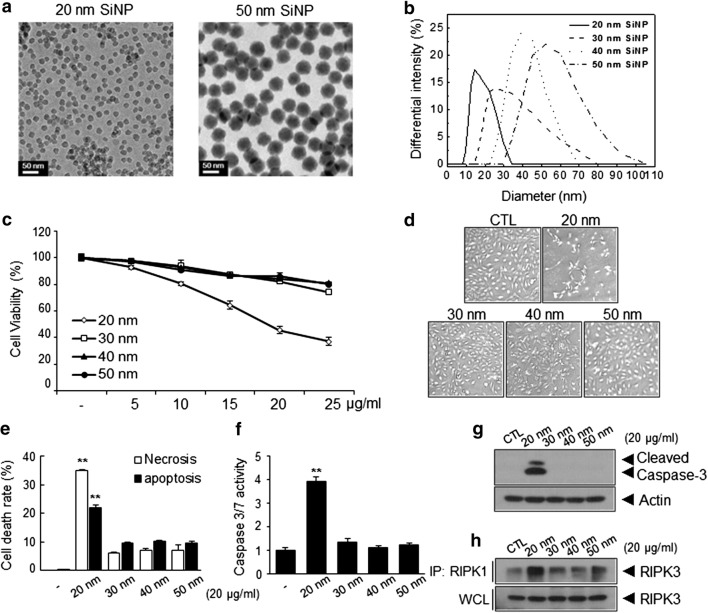Fig. 1.
Characteristics and size-dependent cytotoxicity of silica nanoparticles (SiNPs). a TEM images of 20-nm and 50-nm SiNPs showing that both SiNPs were spherical and displayed monodispersity. b Analysis of DLS data from aqueous suspensions of SiNPs with different sizes ([SiNP] = 1 mg/mL). The size distribution was 18.7 ± 8.4, 30.2 ± 14.2, 37.8 ± 15.0, and 50.4 ± 21.1 nm. Size-dependent cytotoxicity of SiNPs in Human umbilical vein ECs (HUVECs). c Assessment of endothelial cell (EC) viability following treatment with different sizes of SiNPs. Human umbilical vein ECs (HUVECs) were treated with the indicated concentrations of the SiNPs for 24 h in low serum-containing condition and analyzed using crystal violet assay. d Morphologies of HUVECs following treatment with 20 μg/mL SiNPs for 24 h were showed using an optical microscopy, and e representative bar graph of the percentages of apoptotic and necrotic cells as determined by flow cytometric analysis (early apoptotic cell: annexin-V(+)/PI (−), late apoptotic cell: annexin-V(+)/PI (+), and necrotic cell: annexin-V(−)/PI (+); **p < 0.01 versus 30–50-nm SiNPs treated HUVECs). f Relative caspase 3/7 activity of HUVECs treated with 20 μg/mL SiNPs was quantified by Caspase-Glo 3/7 assay systems (**p < 0.01 versus 30–50-nm SiNPs treated HUVECs). Quantitative data are reported as means ± standard deviations. *p < 0.005 versus 30–50-nm SiNPs treated HUVECs. g Western blot analysis of caspase-3 activation in HUVECs following treatment with SiNPs for 24 h. h Interaction between RIPK1–RIPK3 was detected by immunoprecipitation (IP) and western blot analysis

